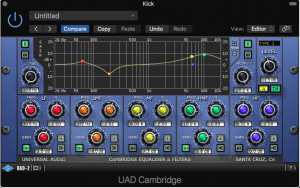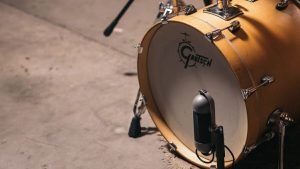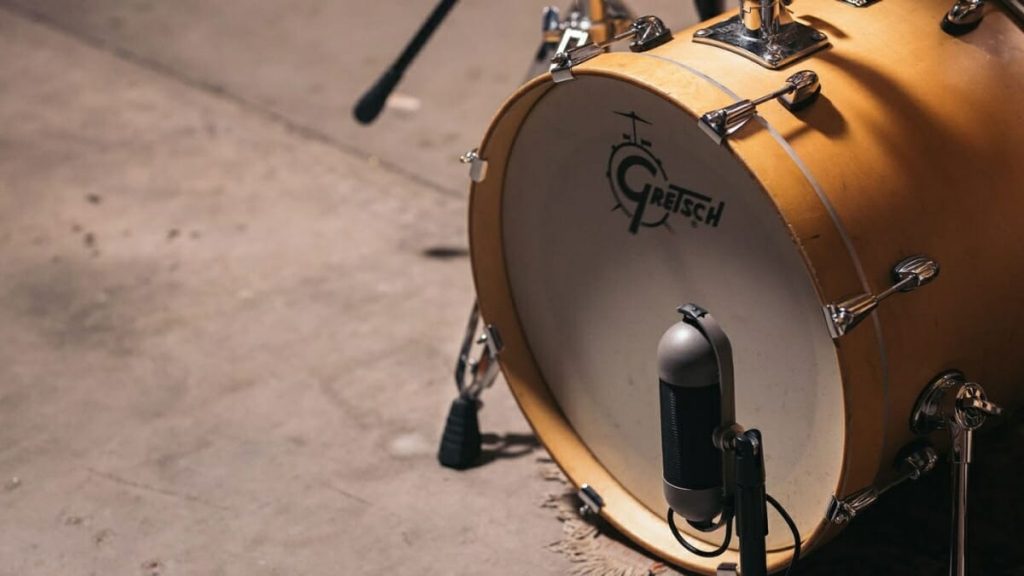
In modern rock, pop, country, and metal (to name but a few genres) the drum sound is an extremely important element to get right to in your mix to make the final product sound punchy & professional. Arguably the vocals are the most important element of any song, but a good drum sound will help propel a mix forward, adding to the overall vibe and impact of the song as a whole. So yes, it’s important.
Getting a powerful kick drum sound, that cuts through the mix, can be surprisingly hard to achieve, especially if you’re just starting out. So in this series of posts, all about kick drum processing, I aim to dispel some myths about the process, and help you get killer kick sounds in your mixes.
So let’s get into it.
No Easy Results
‘Proven step by step method for an amazing kick sound’
‘Follow these simple steps for a pro kick’
Sorry to break it to you, but this is bollocks…
There is no ‘recipe’ or step by step process of getting a killer kick drum sound (despite the internet being full claims to the contrary). The true path to quality mixes is persistence and practice in recording and mixing. However, there are many pitfalls that I wish I knew about when I was starting out. And that’s what this post is focusing on.
If your mix is muddy and unclear, your kick will struggle. If your bass is too loud, or poorly EQed, your kick will struggle. If your overheads overhead mics have captured a ‘boxy’ sounding kick, the close mic will struggle. So on and so forth.
Here are a couple of examples to listen to:
As you can hear in the ‘bigger kick drum’ example the kick sounds fuller, more powerful, louder and clearer than the other one.
The only thing that has changed here is cutting some lower mids in the bass and guitars. Take a look at the image below. I bussed the guitars and bass together (again not saying you should do this) and made a cut at around 160Hz.
That’s it! Yet it’s had a positive impact on the kick sound!
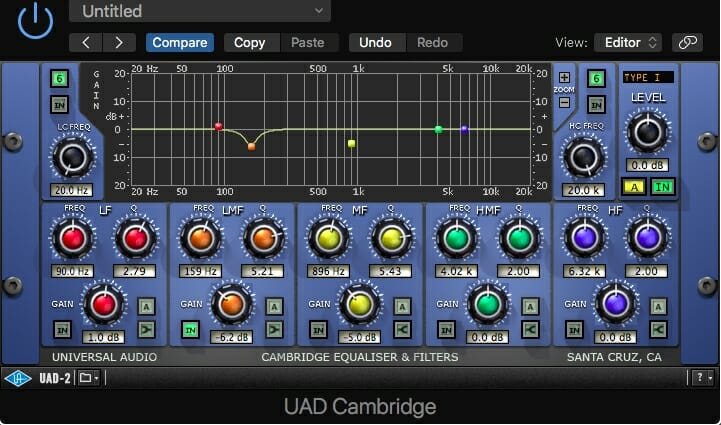
(Note: This is just an example of how the mix can affect the kick sound, I’m not saying you should use this as a technique)
Is Your Mix Killing Your Kick Drum?
There’s a really easy way to check if this is the case: Solo your drums… does everything sound pretty good? Then drop the rest of the mix in… has your kick sound fallen apart? If this sounds familiar, then it’s time to read on.
I know it might be hard to stomach, but it’s the truth. But never fear, keep reading and we’ll focus on ways to make sure your mix is fit for a killer kick drum sound! (Then in the rest of the post we’ll be focusing on the kick itself!)
Make sure the rest of your drum kit is helping, not hindering your kick drum sound.
Let’s assume you’re working on a rock song with 10+ microphones across the kit. Stereo Overheads, Stereo Room, Close Mic toms, Snare and Kick. There’s a huge amount there that can get in the way of a clear and punchy kick sound.
Phase Coherence – Don’t do ANYTHING until you know this is good
Firstly, and most importantly, make sure all your drums are in phase with one another. I can do this by ear, but it can take a bit of practice. However, with the modern DAW, you can just take a look at the waveform and invert them or line them up. See below for a visual example.
I cannot emphasize enough how important this is. Your kick will sound like poop in the mix if other parts of the kits are cancelling it out.
If you’re unsure, just line em’ up in the DAW! Just do it… please!

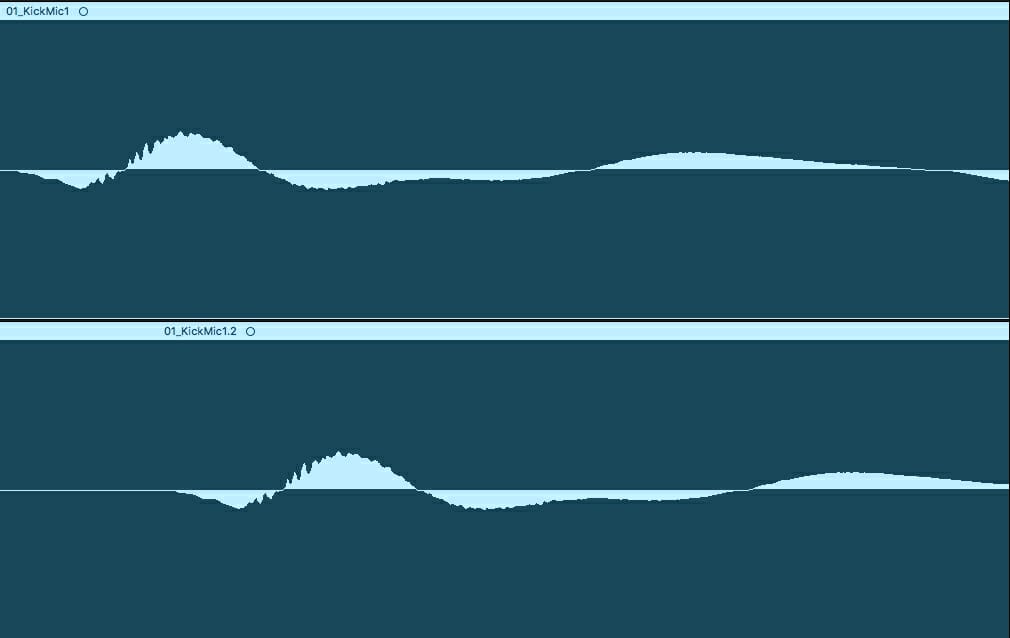
Gate Appropriate Parts Of The Kit.
There’s some debate about gating kick and snares (more on this later) but gating your toms, so there are not overly interfering with the kick (and the rest of the mix for that matter) is really important.
Take the floor tom for example, usually we’ll push some upper mids/ high end to give it some clarity, and also add some low end to ‘beef’ it up. (Yes it’s a generalisation, but I’ve never had a mix where this wasn’t necessary outside of Jazz)
That extra low end will seriously interfere with the kick sound if you leave it in there. So whip your gates out on the toms, and clean that kit up a bit!
Overheads & Room Microphones.
The same principle applies with other elements of the kit. If you mix your drums in solo you might be tempted to add more low end to your overheads and room to ‘beef’ up the kit. But this is a recipe for disaster if you want punchy kick sound.
The key with the stereo elements of the kit is to cut low end through high pass filtering and carefully cut other low/ lower mid ‘boxy’ frequencies and therefore letting the close mic kick ‘cut through’ sounding more powerful, deeper and puncher than otherwise possible.
Not only will this help your kick in the mix, it will give you a better foundation to build up the rest of your mix.
(The image below shows the eq cure on my latest mix of this punk rock track. I focus on cutting as much low/ low mids out WITHOUT making it sound unnatural. Pushing your high pass filters too high can really kill the warmth and vibe of room and overhead sounds.)
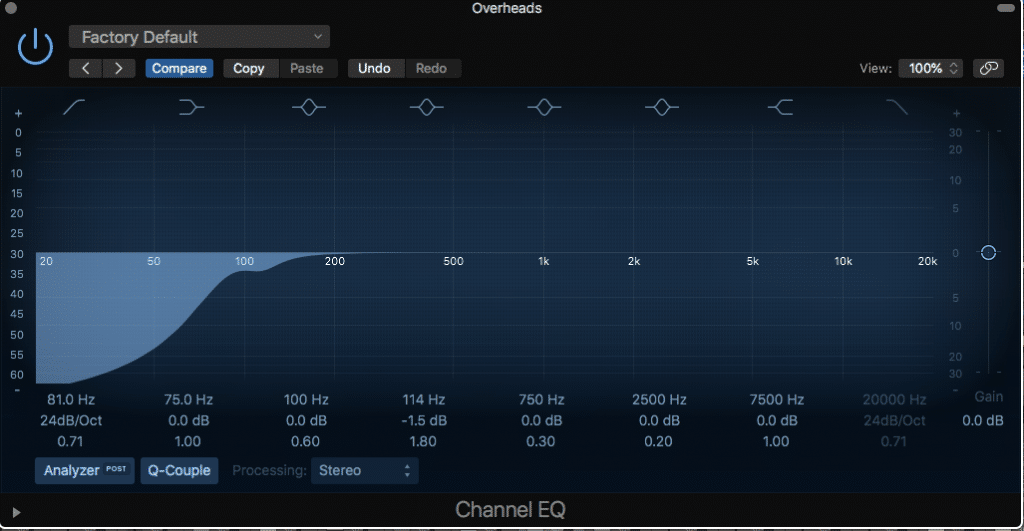
Take a listen to the samples below to see how the HPF & low mid cuts help the kick really cut through. (Gain on the EQ staging has been matched). It also really worth placing a HPF on the close snare too, but again make sure it’s not so high it’s make the snare sound unnatural.
Taken together this will massively help your kick sound much better. Let’s take a listen to the sample below demonstrating what’s been done so far.
Quite a difference right? And we haven’t even touched the kick drum yet!
Giving advice on the rest of the mix (to help your kick) is going to be difficult as ever mix is different and presents unique challenges. However, there are some principles that apply to almost all circumstances in modern pop, rock, metal and the like. I would say that only classical and Jazz are genres where this advice will not apply.
Compress your bass.
The volume of the bass instrument can massively affect the sound of your kick. An uncompressed/ lightly compressed bass will, by its nature, end up louder in the mix than a tightly compressed one. This extra volume can easily swallow a kick drum whole, then the kick comes up in volume to compensate and your carefully crafted sound ends up being undone.
Make sure the lower mids of the mix have been well dealt with.
As we’ve seen, certain instruments like guitar and bass can affect the sound of your kick drum. This also applies for other mid-range instruments, such as piano, synths and the like. They can take up a lot of lower-mid energy, effectively muddying up your mix.
A useful technique to check if this is happening is to drop the whole mix into mono on some good quality headphones and bring each midrange element in and out. I call this ‘channel checking’. Solo the drums, then start to drop in in the other elements of the mix one by one.
If you hear the lower mids on that channel to affect the clarity of the mix then carefully cut out frequencies where appropriate.


